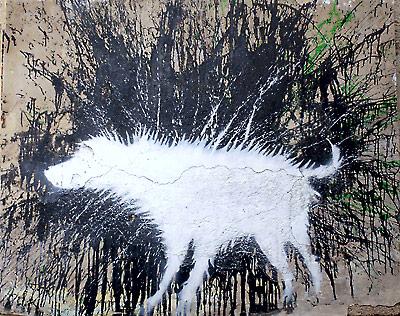Banksy Show Stirs Controversy

It was a journey of thousands of miles and thousands of dollars, but two pieces weighing more than two tons each, stenciled by the English artist Banksy in the Palestinian West Bank, are now on view in Southampton. While more than 2,000 people have seen them in their new location, not everyone is happy about it, including the artist’s representatives.
Pest Control, the organization that acts as the official arbiter of all things Banksy (who continues to remain anonymous because his street works are legally considered vandalism), told ArtNet recently that it had not authenticated any of the street-art works in the show, at the Keszler Gallery. The organization said it would not evaluate any Banksy work that has been removed from its original site, adding that it had warned Stephan Keszler that there would be “serious implications of selling unauthenticated works.”
Mr. Keszler, the art dealer who took the works to a former power plant on North Sea Road in Southampton (one of the few places on the South Fork that could handle their weight), is no stranger to controversy. A few years ago he invited Russell Young, an English artist whom he represents, to a Scope art fair in Miami, where Mr. Young pulled silk-screen works using his own blood.
On Monday, Mr. Keszler said Pest Control has never contacted him. “They did not warn us up front and did not come after us with proof that they are not real pieces. Further, we are a secondary market and have no need to get authorization from Pest Control.” He added that “we have a lot of proof from the Web site and other documentation that these are real Banksy pieces. I believe they would come after us with all legal recourse if this was not the case.”
Mr. Keszler said the pieces have been on the artist’s Web site, although they do not appear to be there anymore. Both are seen in a video on YouTube showing them first in a yard and then being packed up to move to England, being restored, and being shipped off to America.
The artist is believed to have painted “Stop and Search,” an image of a girl in a pink dress frisking a soldier, and “Wet Dog,” which depicts a shaggy dog shaking water off his coat, in 2007. “Wet Dog” was painted on a bus stop’s freestanding wall; “Stop and Search” was part of a building.
“When he made “Stop and Search,” he did not ask the owners of the building whether he could do this,” Mr. Keszler said. “And they did not know about art. They did not like this.” There is a door where the image used to be, according to photographs in the video and to Mr. Keszler. “People had removed it for the man and put it in a box in a yard somewhere for two years.”
The entrepreneurs who removed the pieces started asking around if anyone was interested in the work. “They tried to sell it through eBay, but selling a two-and-a-half-ton work on eBay is difficult,” Mr. Keszler said. Eventually, he said, his partner in the venture, Robin Barton, a British art dealer, found the pieces and was put in contact with the men who had removed them. Mr. Barton, he said, was the one who negotiated their export from Palestine, adding that both Israeli and Palestinian government approval had been received before the pieces were moved out of the country.
Mr. Keszler said he became involved because of his previous show of Banksy’s prints in Southampton three years ago, which included some of his own inventory and works owned by collectors. “I saw his work a while ago and thought he was a very smart artist. I got into Banksy’s work more and more and wanted to show originals.” One work, a painting of a rat with text, was seen in a film about Banksy called “Exit Through the Gift Shop.”
The art dealer said he was not showing the works for money and would prefer to donate them to a major museum. Referring to bloggers who have complained that he was holding the exhibit for his own gain, he said, “It disturbs me that they talk about the event and me in an unfriendly way.” He noted that the 2,000 people who have seen the works in Southampton may never had had the opportunity had they remained in the West Bank. “We did something very good for Banksy and art lovers,” he said.
He is now looking for a space in Manhattan’s meatpacking district with solid flooring, able to withstand the five tons-plus weight of the two works in order to show them in the city.
